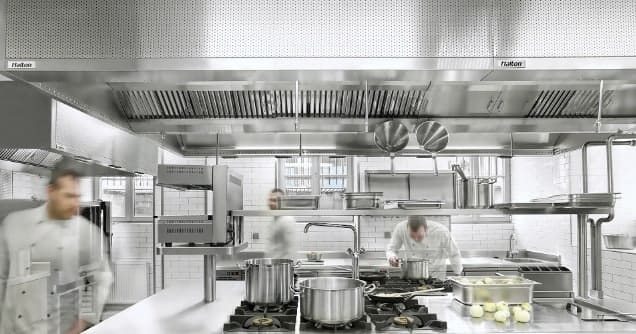
Early adopters are seeing improvements in several areas of food service operations. The HVAC and exhaust systems are the greatest energy consumers in a commercial kitchen.
Significant advances in demand control ventilation have been developed since its adoption. ASHRAE 90.1 (American Society of Heating, Refrigeration, and Air Conditioning Engineers) established energy-saving measure for exhaust systems greater than 5000 cfm. Some municipalities have lowered that to 2500. Historically, most DCVs have used a simple RTD (Resistive Temperature Detector) to measure temperature. As the temperature changes, the electrical resistance changes at a known rate, correlated to a temperature reading.
The introduction of infrared sensors realized a breakthrough in the accuracy and response time of DCV systems. These sensors can detect average surface temperatures of appliances, whereas RTDs rely on the convective plume to rise within the canopy to measure temperature. This causes a delay in response time. Subsequently, the Infrared sensors have been replaced by thermal imaging sensors that can measure specific temperature points (upward of 192 separate locations) of the cooking surface, opening up various applications beyond a DCV system.
- IoT platforms with cloud storage for measured data allow for analytics that ultimately provide services such as predictive maintenance and ventilation optimization based on usage. One such platform is Halton Connect.
- Connected Kitchen Ventilation Ecosystems: This connectivity will facilitate centralized control, remote monitoring, and predictive maintenance, leading to improved ventilation and maintenance management and reduced downtime. Halton SafeGuard employs its cellular modem for the secure transfer of data to the cloud.
- With the sophistication of a thermal imaging sensor, demand control can be further tuned to squeeze out every last energy savings from the system. With the ability to distinguish between appliances and their current status, the system can ramp up exhaust incrementally since it is not averaging temperatures.
An additional use of the thermal imaging sensors within the system provides the ability to determine when conditions are favorable for a fire and before the release of the fire suppression system. Halton’s FireWatch is a 24/7 electronic preemptive fire warning system with data backup.
- With the increased awareness of indoor air quality, the ability to measure Indoor Environmental Quality is increasing (IEQ). Adding to an IoT platform, an IEQ sensor is a natural fit. These devices measure CO2, Temperature, VOC, and Particulate Matter and adjust automatically to sensor input to maintain IEQ. There is a direct correlation between CO2 build-up in the space and virus spread. The system automatically allows for increased ventilation rates to prevent the build-up of CO2. Halton AirWatch is part of the Halton SafeGuard system.
It’s important to note that while these trends represent the potential future of commercial kitchen technology, the pace of adoption and implementation may vary based on cost, infrastructure, regulations, and industry demands. As technology development accelerates, the cost to implement them decreases. We are at the forefront of technological advancements that will transform the food service industry.
